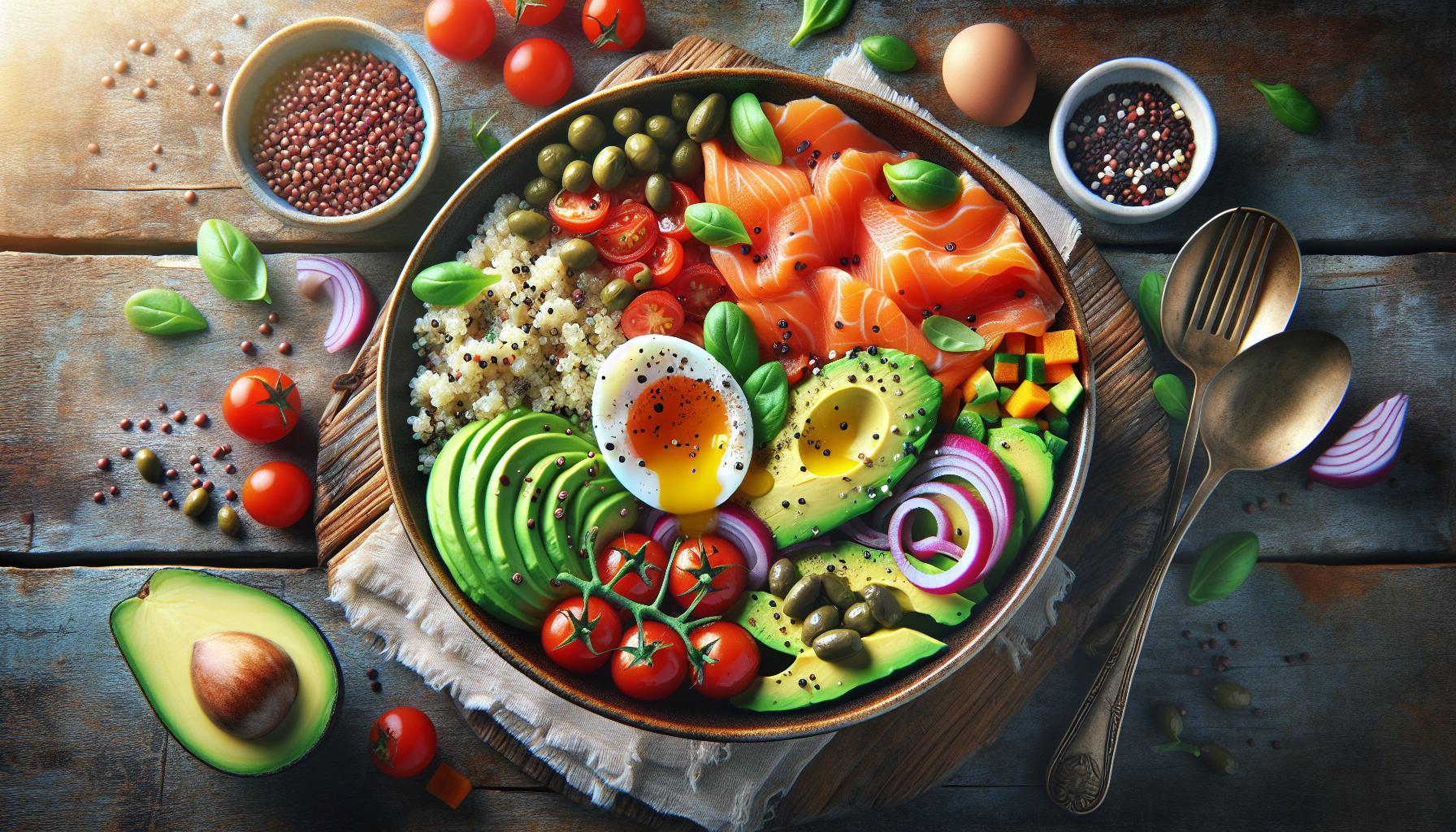Diving into the world of Healthy Pescatarian Recipes doesn’t mean getting stuck with boring fish dishes day after day. From succulent salmon to zesty shrimp tacos, pescatarian recipes offer an ocean of delicious possibilities that’ll make taste buds dance while keeping health goals on track.
The pescatarian lifestyle combines the best of both worlds – all the heart-healthy benefits of seafood with the vibrant variety of vegetarian cuisine. It’s perfect for anyone looking to reduce their meat consumption without going full vegetarian. Plus, with omega-3 fatty acids, lean protein, and essential nutrients packed into every bite, these recipes prove that eating healthy doesn’t mean sacrificing flavor.
Healthy Pescatarian Recipes
A Healthy Pescatarian Recipes combines vegetarian eating patterns with seafood protein sources. This approach excludes meat products like beef, pork, poultry while including fish, shellfish, eggs, dairy products, fruits, vegetables, legumes, nuts and grains.
Health Benefits of Following a Pescatarian Lifestyle
Pescatarian diets offer significant nutritional advantages backed by research studies:
| Nutrient Benefits | Amount per 3oz Serving |
|---|---|
| Omega-3 Fatty Acids | 1,000-2,000mg |
| Protein | 16-22g |
| Vitamin B12 | 2.4mcg |
| Iron | 0.6-0.9mg |
Studies link pescatarian eating patterns to:
- Lower rates of heart disease by 24% compared to meat-eaters
- Reduced inflammation markers in the body
- Decreased risk of type 2 diabetes by 19%
- Better weight management through lean protein intake
- Enhanced brain function from omega-3 consumption
Environmental benefits include:
- 50% lower carbon footprint than meat-based diets
- Reduced water usage compared to livestock farming
- Less land requirement for food production
- Selective fish consumption from responsibly managed fisheries
- Integration of plant-based protein sources
- Reduced reliance on factory farming
Essential Ingredients for Pescatarian Cooking

A well-stocked pescatarian kitchen combines fresh seafood with plant-based ingredients to create nutritious meals. These foundational ingredients enable diverse recipe creation while maintaining the diet’s health benefits.
Fresh Fish and Seafood Options
Fresh seafood forms the protein cornerstone of pescatarian cooking. Wild-caught salmon delivers high omega-3 content at 2.6 grams per 3.5-ounce serving. Sustainable white fish varieties include cod, halibut pollock offering 15-20 grams of protein per serving. Shellfish options encompass shrimp, mussels scallops packed with vitamin B12 zinc. Canned alternatives such as tuna, sardines mackerel provide convenient protein sources with 2-3 year shelf stability. Local fish markets offer seasonal catches like mahi-mahi, trout bass based on regional availability.
Plant-Based Staples
Plant proteins complement seafood in pescatarian meal planning. Legumes include lentils (18g protein/cup), chickpeas (15g protein/cup) black beans (15g protein/cup). Whole grains such as quinoa, brown rice farro supply complex carbohydrates fiber. Fresh produce encompasses leafy greens, cruciferous vegetables seasonal fruits. Nuts seeds provide healthy fats – almonds (14g fat/oz), chia seeds (9g fat/oz) walnuts (18g fat/oz). Essential pantry items include olive oil, tamari coconut milk for creating flavorful sauces marinades. Nutritional yeast adds B vitamins umami flavor to dishes.
Quick and Easy Pescatarian Breakfast Ideas

Starting the day with protein-rich pescatarian breakfast options energizes the body while providing essential omega-3 fatty acids. These quick recipes take less than 15 minutes to prepare.
Smoked Salmon Breakfast Bowl
A protein-packed breakfast bowl combines cold-smoked salmon with quinoa creates a nutritious morning meal. The base consists of 1 cup cooked quinoa topped with 3 ounces of premium smoked salmon slices. Fresh ingredients including diced cucumber, cherry tomatoes, avocado slices add vibrant flavors and textures. A soft-boiled egg provides extra protein while capers contribute a tangy burst. The bowl comes together with a light dressing of lemon juice, extra virgin olive oil, fresh dill sprigs, plus a sprinkle of everything bagel seasoning.
| Ingredient | Amount | Nutrition (per serving) |
|---|---|---|
| Quinoa | 1 cup | 222 calories |
| Smoked Salmon | 3 oz | 99 calories |
| Avocado | 1/2 fruit | 161 calories |
| Egg | 1 large | 72 calories |
Mediterranean Tuna Toast
Mediterranean tuna toast elevates ordinary breakfast with protein-rich canned tuna mixed with Greek flavors. Premium olive oil-packed tuna combines with diced red onions, cherry tomatoes, kalamata olives. Fresh herbs like oregano, basil leaves enhance the Mediterranean profile. The mixture spreads on toasted whole grain sourdough bread rubbed with garlic. A drizzle of extra virgin olive oil finishes this protein-packed start to the day. This breakfast provides 24 grams of protein per serving.
| Component | Amount | Protein Content |
|---|---|---|
| Tuna | 3 oz | 20g |
| Sourdough | 2 slices | 4g |
| Olive Oil | 1 tbsp | 0g |
| Total | 1 serving | 24g |
Light Pescatarian Lunch Recipes

Light pescatarian lunches combine lean proteins with fresh vegetables for energizing midday meals. These recipes emphasize quick preparation methods while maintaining high nutritional value.
Grilled Fish Tacos
Grilled fish tacos feature flaky white fish seasoned with cumin, chili powder, lime juice. Fresh corn tortillas cradle the seasoned fish topped with crunchy cabbage slaw, diced tomatoes, avocado slices. A citrus crema made from Greek yogurt, lime zest, garlic adds tangy creaminess without excess calories. Each taco contains 15g of protein, making them ideal for sustained energy throughout the afternoon. These tacos cook in 12 minutes on a preheated grill or grill pan, perfect for busy lunch schedules.
Shrimp and Quinoa Salad
Shrimp and quinoa salad combines protein-rich ingredients with Mediterranean flavors. Chilled quinoa serves as the base for succulent grilled shrimp, cucumber, cherry tomatoes, red onion, kalamata olives. Fresh herbs like mint, parsley, dill brighten the dish while lemon vinaigrette ties the components together. This salad provides 22g of protein per serving plus 8g of fiber from the quinoa and vegetables. The entire dish takes 20 minutes to prepare, including cooking the quinoa and shrimp. Leftovers stay fresh for 3 days when stored in an airtight container.
Nourishing Pescatarian Dinner Dishes
Pescatarian dinner recipes combine the richness of seafood with vibrant vegetables to create satisfying evening meals. These nutrient dense dishes deliver essential proteins omega 3 fatty acids while incorporating colorful produce.
Pan-Seared Cod With Roasted Vegetables
This Mediterranean inspired dish pairs flaky cod fillets with seasonal roasted vegetables for a complete meal. The cod cooks in 4 minutes per side in a cast iron skillet with olive oil garlic salt pepper creating a golden crust. Roasted vegetables including Brussels sprouts cherry tomatoes bell peppers toss with herbs olive oil at 400°F for 20 minutes until caramelized. Each serving provides 24g protein 12g fiber 320 calories making it an ideal balanced dinner option.
| Nutritional Info | Amount |
|---|---|
| Protein | 24g |
| Fiber | 12g |
| Calories | 320 |
| Cook Time | 25 min |
Spicy Garlic Shrimp Stir-Fry
This Asian inspired stir fry combines jumbo shrimp with snap peas carrots broccoli in a spicy garlic sauce. Fresh shrimp marinate in minced garlic chili paste soy sauce for 10 minutes before cooking. The vegetables stir fry in sesame oil for 3 minutes maintaining their crunch. Adding the marinated shrimp to the hot wok creates a flavorful dinner in under 15 minutes. One serving contains 28g protein 8g fiber 285 calories.
| Nutritional Info | Amount |
|---|---|
| Protein | 28g |
| Fiber | 8g |
| Calories | 285 |
| Cook Time | 15 min |
Meal Prep Tips for Pescatarian Success
Efficient meal preparation streamlines pescatarian cooking while maintaining food safety standards. These guidelines optimize seafood storage and weekly meal planning for maximum freshness and convenience.
Storage Guidelines for Fish
Fresh fish storage requires specific temperature control and proper packaging techniques. Raw fish stays fresh for 1-2 days when stored at 40°F (4°C) in an airtight container on the bottom shelf of the refrigerator. Cooked fish maintains quality for 3-4 days when refrigerated in sealed containers. For extended storage, wrap fish tightly in moisture-proof freezer bags, removing excess air to prevent freezer burn. Frozen fish retains optimal quality for 3-6 months at 0°F (-18°C). Thaw frozen fish gradually in the refrigerator for 24 hours before cooking to maintain texture and flavor.
Weekly Planning Strategies
Effective pescatarian meal planning starts with selecting 2-3 types of fish or seafood per week. Purchase fish on shopping day one for immediate cooking and freezing portions for later use. Schedule fish meals earlier in the week to ensure peak freshness. Batch cook plant-based components like grains, legumes, and roasted vegetables on weekends. Prep versatile sauces and marinades in advance, storing them in portioned containers for quick meal assembly. Create a rotating schedule incorporating different cooking methods – grilling on Monday, baking on Wednesday, pan-searing on Friday – to maintain variety while simplifying preparation.
Pescatarian Diet
Embracing a Healthy Pescatarian Recipes lifestyle offers a perfect balance of health conscious eating and culinary adventure. The combination of fresh seafood and plant-based ingredients creates endless possibilities for nutritious and delicious meals throughout the day.
With proper planning storage techniques and a well-stocked pantry anyone can successfully maintain this sustainable dietary choice. From quick breakfasts to satisfying dinners pescatarian recipes prove that healthy eating doesn’t mean sacrificing flavor or variety.
The significant health and environmental benefits of this diet make it an attractive choice for those looking to make positive changes in their eating habits while still enjoying delicious meals.

